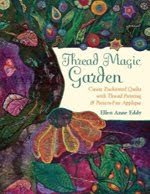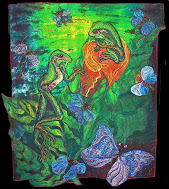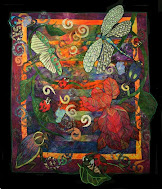Thursday, November 12, 2009
Musings :Art out of the Box: Fairy Gifts
 My great grandmother believed in fairies. She did not believe in pretty little creatures posing in her garden with wings. She was fairly scared of them as I understand it. But my mother always told a story about her. She swore that when there was terrible trouble or someone was deathly ill, there would be a knock on the door. And if you opened it, it would be so dark or so foggy that all you saw would be a hand. And in the hand would be a bottle or a pot of ointment.If you took that offering, everything would change. It might look like poison or cure, the person might get better immediately or not. But the certainty was that change was already on it's way.
My great grandmother believed in fairies. She did not believe in pretty little creatures posing in her garden with wings. She was fairly scared of them as I understand it. But my mother always told a story about her. She swore that when there was terrible trouble or someone was deathly ill, there would be a knock on the door. And if you opened it, it would be so dark or so foggy that all you saw would be a hand. And in the hand would be a bottle or a pot of ointment.If you took that offering, everything would change. It might look like poison or cure, the person might get better immediately or not. But the certainty was that change was already on it's way.I do believe almost all great creative gifts start with something that looks like a limit. I've never believed you have to suffer to make great art. But I have a notion how that idea evolved. Art does transform our pain, so it's much more likely we'll work on our art when we're hurting.
A huge amount of what defines us is what we can't do. Klutzy as I was as a child,socially inept and ill most of the time, I spent most of my time making things. As dyslexic as I am, I know I see the world quite differently than others. My spelling grades and inability to read a map or a calendar are proof of that. But I believe that adds to my world vision, to the bit of the world only I can see or show through my art. My hands started to tingle and go numb at around 16. It meant I couldn't do hand work, so I found I could to astonishing things with my machine.Currently, my knees are so painful I'm having trouble with the studio stairs. Which is why I find myself compelled to write. Our limits make us who we are.If we embrace them, our limits are what make us whole. The fairy's curses became huge gifts in time, and I am grateful for them.
We probably would have given Grandmother Ryan a lot of Zoloft now-a-days. I wonder how many visionaries, artists, musicians and saints we medicate out of existence. Would their lives have been better without visions, fears, limits, pain and the attendant terror that goes with that? It's easy to say they might have been. But something dreadful would have been lost. Like a child, a pet, a love or a vocation, these gifts our ours only if we completely integrate them into our lives. We have to accept it completely, sometimes, for it's best parts to be part of us. Sometimes the gifts look like great and lovely wrapped packages, but much more often they appear to be terrible curses at first. Only in the process of acknowledging them, assimilating them, and affirming them, do we see that the fairies really were kind. But they do demand action and change. Perhaps that's what my great grandmother was afraid of. Perhaps she wasn't all that over an edge.
Wednesday, November 11, 2009
Musings: Art outside the box: Dyeing for color
In a world with millions of bolts of fabric, why is it I still drag myself out to the dye studio once a month and dye 50 yards of cotton? I've had numerous people tell me how fun that sounded. They usually feel a bit differently about it after around 10 yards of dyeing in class. They adore their fabric, but no one is pretending this isn't pretty backbreaking work. Liking having a baby, when it all comes out, you forget just how much work it was.
I'm a relic of the 70s, someone who was quilting from 1975. Fabric choices then were left over fashion choices. There was no real quilt industry or real quilt fabric. There were some serious holes in the color wheel. These changed with the seasons and the fashions. There were no purples in the 70s, no oranges or brights in the eighties, and no choices in yellows until the early 90s. And there were never ever enough grays. So early on, I began to dye my fabrics, first in gradations, and later in light source fabric that's signature for me now.Quilting fabric began to come in by the mid 80s, but by then, I was able to dye what I needed.
I think the real truth is that we all see color so differently, that I'm disappointed by other people's vision. They tell us that color vision is very individual. The extreme end is color blindness, but it's clear people don't see the same things.
I've always had a good color eye. That doesn't mean that I understood color when I was starting. I simply was able to see it well enough to choose well. I began to study color theory when I was asked to to a color lecture. After several hours in the library, listening to what appeared to be male silliness like color formulas, charts, color tone symphonies, etc. I simply called the recipes and called the lecture The Color Cookbook. Since then, I've spent a lot of time learning to codify the choices I make by nature, to explain them to students. We forget that color theory is only a theory. It's a work in process. We know it fails us from time to time and we're still looking for a better way to describe how it works.
The fabrics I dye are sponge dyed. They're designed to create a small universe of their own, a perfect world for one of my creatures. Many people prize them for appliqué and piecing as well, but that's my usual intent. So I build in a light source, shadows to weight the piece, flowers in the dye, trees in the shading. It's also an art by accident. I have some control, but not over everything. If I dye for a particular reason, I'll dye a piece 3 times to get the one I want. And sometimes need to go back to try again.
Why? The colors created with fiber reactive dyes are strong, vibrant, color fast and exquisite. They're not limited to only brights or pastels, although it can do both. And every piece of art I start, starts with a unique piece of art in the fabric alone.
So why did I start dyeing threads? Similar reasons. Almost all of the earlier variegated threads are in rainbow colors. Who over the age of 3 1/2 wants a rainbow colored anything? They stipple well, but they're impossible for shading imagery. Many of the new variegated threads have stretched past that. But they don't know how to create a thread to shade an image.
It's not that hard. Every story has a beginning, a middle and an end. Every image has a dark, a medium and a light. Along the way it should have shaders to weight the piece and shockers to wake up the viewer. I've dyed pearl cottons now for over 10 years to get that ability to shade an image to my liking.
I've started doing bobbin weight thread kits for The Cotton Club with patterns and threads designed to make shading easy and fun. You can join the club and get a new project with instructions each month.Check them out at www.cottonclub.com
So why do I dye clothes? Well there is the great cycle of dye. You wear it. You spot it. You dye it. You wear it until it's dead. Then you wear it to dye things in.
But truly, it's a diet secret.The first time I dyed a dress for myself, I wore it to a gallery shoot. I blended right into my work. The photos showed a very pretty disembodied head among the quilts. It was like I'd lost 150 pounds. Now who wouldn't like that?
I swore I'm done being a victim. At least never a fashion victim. Fashions can come and go, but since I dye my own I always have the colors I live and breathe in, waiting for me.
Ellen Anne Eddy's Dye Day Workbook is available at
www.ellenanneeddy.com
Ellen Anne Eddy's Hand-dyed Thread Club is available for order at
www.cottonclub.com
Ellen Anne Eddy's Dye Day Workbook is available at
www.ellenanneeddy.com
Ellen Anne Eddy's Hand-dyed Thread Club is available for order at
www.cottonclub.com
Tuesday, November 10, 2009
A Ladybug's Garden
A Ladybug's Garden is my brand new project book, just sent to the printers today! Here's a sneak peak at it.
It includes a full step-by-stop ladybug project focusing on free motion zigzag embroidery. It has full instructions, supply list, patterns, tips, a gallery section, and sources.
This book is a companion volume to my class. A Ladybug's Garden, but it can be used separately to build your skills with free motion zigzag applique.
It covers direct appliqué, cut-away applier, hard edge appliqué, soft edge appliqué, shading, and slashed appliqué. It's a primer of powerhouse embroidery skills for the free motion stitcher.
Available by eary December, 2009. You can pre-order this book at www.ellenanneeddy.com
Subscribe to:
Posts (Atom)
Ellen Anne Eddy's Flowers on Youtube.com
Labels
lunatic fringe
(22)
design
(18)
life as an artist
(18)
lifestyle
(18)
story telling
(11)
art quilting
(8)
fiber art
(8)
art quilters
(7)
books
(6)
color
(6)
free motion
(6)
gardening
(5)
Thread Magic Garden
(4)
embroidery
(4)
quilters
(4)
quilting
(4)
C and T Publishing
(3)
craft
(3)
flowers
(3)
Christmas
(2)
What problem?
(2)
archetypes
(2)
beads
(2)
bias
(2)
bobbin work
(2)
classes
(2)
filling the grid
(2)
sewing
(2)
threads
(2)
zigzag stitch
(2)
Wizard of Oz
(1)
choir
(1)
knitting
(1)
machine stitching
(1)
movies
(1)
seasons
(1)
youtube
(1)
Like us on Facebook
Quiltposium, Fall2011

Ellen's New Article, Dance of Design
Essential Embroidery Stitches: Free Hand and Machine Embroidery Designs and Techniques.
The Butterfly Effect

My Blog List
-
2 days ago
-
1 week ago
-
1 month ago
-
4 months ago
-
6 months ago
-
8 months ago
-
3 years ago
-
3 years ago
-
3 years ago
-
4 years ago
-
5 years ago
-
5 years ago
-
6 years ago
-
7 years ago
-
7 years ago
-
7 years ago
-
7 years ago
-
8 years ago
-
9 years ago
-
9 years ago
-
9 years ago
-
9 years ago
-
10 years ago
-
10 years ago
-
10 years ago
-
10 years ago
-
11 years ago
-
11 years ago
-
11 years ago
-
11 years ago
-
11 years ago
-
11 years ago
-
11 years ago
-
11 years ago
-
12 years ago
-
-
-

Facebook Badge
Labels
archetypes
(2)
art quilters
(7)
art quilting
(8)
beads
(2)
bias
(2)
bobbin work
(2)
books
(6)
C and T Publishing
(3)
choir
(1)
Christmas
(2)
classes
(2)
color
(6)
craft
(3)
design
(18)
embroidery
(4)
fiber art
(8)
filling the grid
(2)
flowers
(3)
free motion
(6)
gardening
(5)
knitting
(1)
life as an artist
(18)
lifestyle
(18)
lunatic fringe
(22)
machine stitching
(1)
movies
(1)
quilters
(4)
quilting
(4)
seasons
(1)
sewing
(2)
story telling
(11)
Thread Magic Garden
(4)
threads
(2)
What problem?
(2)
Wizard of Oz
(1)
youtube
(1)
zigzag stitch
(2)







